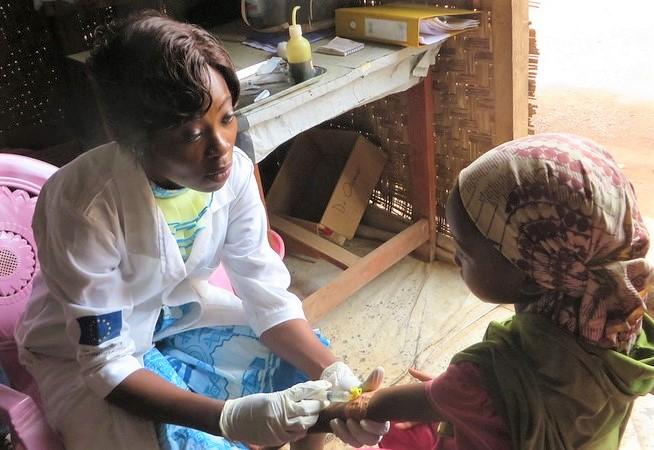A new study in The Lancet Infectious Diseases has found that children in eight low- and middle-income countries (LMICs) receive a remarkably high number of antibiotics by the time they reach the age of 5.
The study, which looked at data on sick children who attended healthcare facilities in Haiti, Kenya, Malawi, Senegal, Namibia, Nepal, Tanzania, and Uganda over a 10-year period, found that the average number of antibiotic prescriptions written for children between birth and the age of 5 in these countries was 25.
Furthermore, although researchers from the Swiss Tropical and Public Health Institute and Harvard TH Chan School of Public Health weren't able to directly assess whether the prescriptions were appropriate, they estimate that anywhere from half to 80% of them are likely unnecessary.
"Overall, the results of our study suggest that antibiotic exposure of children in LMICs is extremely high, and that antibiotics prescriptions are, to a large extent, issued inappropriately," the authors of the study wrote. "Given there are more than 500 million children younger than 5 years in LMICs, the contribution of this population to global antibiotic consumption, and therefore to the selection of antibiotic-resistant bacteria, is substantial."
Illness, treatment increase antibiotic exposure
For their estimates, the researchers used data from two sources: the Demographic and Health Survey (DHS) and the Service Provision Assessment (SPA). The DHS, which collects nationally representative household-level data on the health of women and children, was used to estimate the cumulative number of illnesses in children related to fever or a cough in each country, as well as the cumulative number of visits to a healthcare facility for these illnesses. The SPA surveys, which collect clinical observation data from healthcare facilities, were used to estimate the proportion of children prescribed an antibiotic.
From SPA surveys, the researchers identified 22,519 clinical observations of children younger than 5 years who visited a healthcare facility because of an illness from July 2007 through December 2016. From DHS surveys, they identified 68,826 children younger than 5 years who visited a healthcare facility from May 2006 through November 2016. The SPA surveys indicated that 85.4% of healthcare facility visits were related to either a fever or cough, and that 62.7% of children who visited a healthcare clinic were prescribed an antibiotic.
Overall, antibiotics were prescribed to 80.5% of children diagnosed as having respiratory illness, 50.1% as having diarrhea, and 28.3% as having malaria—conditions that typically don't require antibiotics.
The mean number of antibiotic prescriptions issued to children between birth and age 5 across the eight LMICs was 24.5 (95% confidence interval [CI], 22.6 to 26.7). Uganda had the highest level of antibiotic prescribing, with children under 5 receiving an average of 59.1 (95% CI, 54.1 to 64.6) antibiotic prescriptions. On the other end of the spectrum, children in Senegal received an average of 7.1 (95% CI, 6.3 to 7.9).
By comparison, children in the United States receive on average 1 to 2 antibiotic prescriptions per year, and children in Europe receive less than one prescription for an antibiotic per year, according to previously published research.
Senior study author Jessica Cohen, PhD, a professor of global health at Harvard TH Chan School of Public Health, says the findings came as a surprise to the team, since they had different expectations when they started looking at the data.
"We were expecting to see a lot of examples of under-provision of care," Cohen said. "But this excessive prescribing of antibiotics jumped out quickly from the data. The extent of it was surprising to us."
And these estimates don't take into account non-prescription antibiotic use, since the DHS and SPA surveys don't record antibiotics bought from pharmacies or private retails outlets, which are common sources of non-prescription antibiotics in these countries. Nor did they account for treatment with leftover antibiotics.
Cohen and her colleagues say the high level of antibiotic prescribing they observed is likely the result of several factors. One is that kids in low-income settings tend to be sicker, a fact highlighted by the finding that a third of children in the DHS surveys were reported to have a cough or fever in the 2 weeks preceding the survey.
"All of the factors that are at play in helping kids boost immunity, like good nutrition, safe water, sanitation, and vaccines, are less likely in these settings, so kids are just chronically more sick," she said.
In addition, more than 60% of the children with a cough or a fever received treatment from a formal or informal healthcare facility, which was higher than they expected. Overall, the researchers estimated that families in the eight countries sought treatment for sick children 36 times between the ages of 0 and 5. The flip side of that treatment-seeking is increased exposure to antibiotics.
"The big push over the last 20 years or so has been on encouraging caregivers to bring their kids in for care, and bring them in sooner, and that's a good thing, because many of the children who die from infectious diseases in these settings are brought too late for care," Cohen said. "On the other hand, if all of these kids are getting unnecessary antibiotics, then that is certainly contributing to [the problem] of excessive prescribing."
Cohen and her colleagues also note, however, that their study was not able to assess the impact of antibiotic use on mortality, which Cohen believes could be an important part of the story.
"Child mortality [in LMICs] has been declining over the years, and I'm sure increasing access to care and use of care is an important part of that," she said. "We can't see the other side of this, which is the potential health benefits to what is clearly an excessive antibiotic prescribing rate."
Pressure to prescribe
While seeking professional treatment for sick children is a good thing, the problem is that, in these low-income, low-resource settings, antibiotics may be one of the few tools that healthcare providers have at their disposal. And in places where it may be difficult for people to get to healthcare facilities, providers may feel that this is their only chance to treat a sick child, even if it's unclear that an antibiotic is the right treatment.
"These health workers are working in settings without proper diagnostics, without proper support and supervision and training," she said. "In a lot of cases, it may be that the health workers feel that this is their only touch point with the kids, and prescribing an antibiotic is the safe thing to do."
Amesh Adalja, MD, a senior scholar at the Johns Hopkins University Center for Health Security who was not involved in the study, adds that if clinicians in these settings feel as though parents or caregivers are expecting some kind of medication for a sick child, they may feel pressure to use antibiotics.
"If an antibiotic is the only tool that you have to satisfy that patient, sometimes providers may take the path of least resistance and give them the antibiotic, while knowing that it's not warranted," Adalja said.
Adalja is not surprised by the findings. And he believes that the high level of antibiotic prescribing observed in these low-resource settings is likely driven by some of the same factors that encourage inappropriate antibiotic use in high-income settings.
"What we've seen is that any time you look, you're going to find high rates of inappropriate antibiotic prescribing in whatever population you look at, and we know that children in particular have high rates of inappropriate antibiotic use, because they tend to have many upper respiratory tract infections, and you have some diagnostic uncertainty among clinicians that are treating them." Adalja said. "So often you see [providers] giving children antibiotics just in case."
One thing that might help, said Adalja, is better diagnostic tools.
"Any time that you put diagnostics in the hands of clinicians, they usually do better at prescribing antibiotics, even if those diagnostics are not optimally sensitive," he said. "Being able to tell a patient specifically what they have, and why they don't require an antibiotic, is often very useful for the clinician trying to dissuade someone from using antibiotics."
Cohen says some of the strategies that have helped reduce unnecessary prescribing in high-income countries—like provider report cards, patient and provider education initiatives, and better training on antibiotic prescribing guidelines—may also help reduce prescribing in settings with fewer resources. But ultimately, she says, more research is needed to pinpoint the primary drivers of excessive prescribing in these countries.
"My feeling is that it's really important to have a clear understanding of the reasons why antibiotic prescribing is so high in low-income settings…before deciding to take one approach versus another," she said.
See also:
Dec 13 Lancet Infect Dis study























